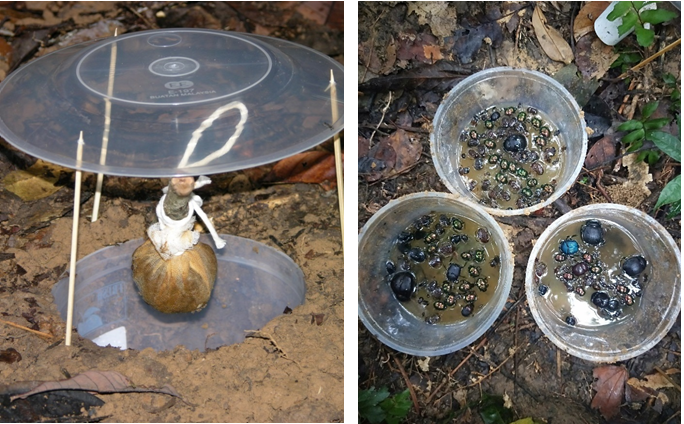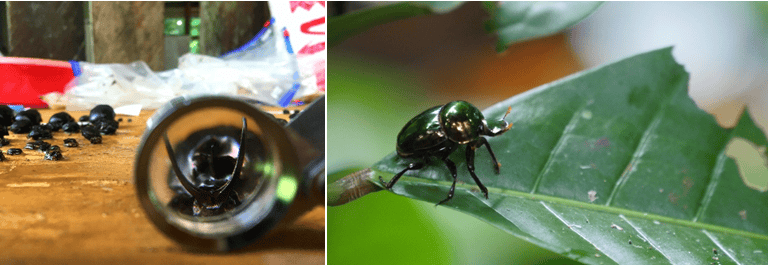- Dung beetles have emerged as one of the most intensively studied animal groups in tropical rainforests.
- They are very easy and cheap to survey and are strong indicators of the health of rainforests and the presence of diverse mammal communities.
- Dung beetles also carry out critical roles and functions in rainforests, including spreading seeds and nutrients, but some of these are unraveling as humans drive species to extinction.
All you need to find out how many dung beetles survive in a damaged rainforest is a plastic cup, a length of string, a plate, a piece of muslin … and a bagful of human feces. In an age where drones, camera traps and bioacoustic devices are fast becoming the new norm for surveying rainforest biodiversity, these are the simple tools that have made dung beetles one of the most heavily monitored animal groups in the tropics. And there’s no school like the old school.
Jos Barlow, a professor of conservation science at Lancaster University in the U.K., thinks one study he was involved in was particularly influential in promoting dung beetle sampling in tropical forests. Published in Ecology Letters more than 10 years ago, and cited on Google Scholar more than 400 times since, this study compared the various costs and benefits of monitoring 14 different wildlife groups in the Amazon, from tiny fruit flies and orchid bees to bats, trees, lizards, large mammals and fruit-eating butterflies.
“The differences in the quality of information we got from each group were clear,” Barlow says.
Dung beetles were not only one of the cheapest groups for the researchers to survey, costing up to 40 times less to monitor than small mammals and 65 times less than fruit flies. They were also among the best indicators of the consequences of habitat change, since the number of dung beetle species found in a particular habitat mirrored how ecologically intact it was.
At the time, this led Barlow and his co-authors to label dung beetles as a “high-performance indicator taxa” — cost-effective and informative to sample.
A full decade on, and with conservation and monitoring efforts in the tropics still grossly underfunded, it’s an epithet that’s stuck.
Once worshiped by Ancient Egyptians who likened the sun’s movement across the sky to a scarab rolling a dung ball, dung beetles today are revered by tropical biologists, who view them as canaries in the coal mine for tracking how humans are ravaging rainforests.
“The great thing about sampling dung beetles is that you can gain a large amount of data quickly, easily and efficiently,” says Felicity Edwards, a tropical forest ecologist and dung beetle researcher at Lancaster University.
Finding out how abundant and species-rich particular animal groups are is usually fraught with difficulties, especially in habitats as densely vegetated and diverse as rainforests. It can take months of painstaking effort for conservationists to properly survey a patch of jungle, and even then, elusive or hard-to-spot animals can still slip under the radar undetected. But with dung beetles, entire communities made up of thousands of insects can be captured and censused reliably in a matter of days.
Together with the fact that individual dung beetle species are known to be particularly sensitive to environmental change, the sheer speed at which dung beetle populations can be surveyed has made the scarabs an ace tool for rapid-fire assessments of forest health.
In Brazil’s Atlantic Forest, the makeup of whole dung beetle communities can tell you how long ago a chopped-down jungle started recovering. In Guyana, two forest-dwelling species of beetle in particular, Canthidium centrale and Deltochilum carinatum, are indicators that a forest is pristine. Two others, Hansreia affinis and Eurysternus caribaeus, are evidence that it’s been logged.

How to catch a beetle
The major advantage of surveying dung beetles is that you don’t need to go out looking for them. Do it right, and all the beetles come to you.
Scientists can catch and monitor dung beetle populations in one of two ways. The first method involves hanging flight interception traps through the forest canopy or understory to catch beetles in mid-air. A more common way is to bury pitfall traps in the jungle floor. But for this to work you need an all-important lure to suck in nearby beetles.
Dung. And lots of it.
“I usually use a mix of pig and human dung,” Filipe França, who studies dung beetles in Brazil, tells Mongabay in an email. “These types of dung are (not always!) easy to get everywhere. Just to give you an example, I needed around 67 kilograms of dung during the field experiments I performed [in the Amazon].”
Edwards herself opted for human dung, known to attract many forest dung beetle species, to demonstrate the far-reaching consequences of road building in Borneo’s rainforests. Setting traps at increasing distances from major logging roads, she showed that the harmful consequences of logging infrastructure on dung beetle communities can reach up to 170 meters (560 feet) into the rainforest interior.
It’s a finding made all the more disturbing given the major road-building projects currently underway across Borneo and Papua, Edwards says, adding that her “study area had only minimal secondary encroachment and additional disturbance, so the impacts could be even more magnified elsewhere.”

From the peaty jungles of the Congo Basin to the mountaintop cloud forests of the Colombian Andes, dung beetles have emerged as an unlikely candidate for strong-nosed scientists to explore ecological questions. So when Barlow set out to lead the most comprehensive survey ever made on how human stressors are interacting across vast portions of the Brazilian Amazon, dung beetles once again scuttled to the fore.
“They are relatively easy and quick to sample — which is essential when assessing over 400 different transects spread across 36 different [drainage] catchments,” Barlow says.
Alongside complimentary data collected for birds and trees, Barlow and his team’s dung beetle surveys showed that forest disturbance due to a combination of logging, wildfires, edge effects and hunting can impoverish Amazonian forest wildlife as much as outright deforestation.
For forest conservation goals, this means it’s not enough to just maintain tree cover for wildlife. The quality and intactness of rainforests matters just as much as the quantity. And for dung beetles, whose very survival depends intimately on the availability of mammal dung, the presence of healthy mammal communities matters perhaps most of all.
The great beetle extinction?
Seven thousand years ago, when Europe’s megafauna collapsed under the weight of burgeoning human pressure, so too did its dung beetle populations. Today, as bushmeat hunting and the wildlife trade continue to decimate even some of Earth’s most remote rainforest mammal populations, scientists are once again fretting about the ugly world of co-extinctions.
Many people have heard about the plight of the Sumatran rhino, orangutan and clouded leopard. But what if, as these animals are disappearing, whole species of dung beetle are following them into the abyss — some never described? What if, as well as worrying about endangered species, we should be concerned about endangered feces?
It’s usually assumed that forest-dwelling dung beetles are relative generalists, able to nest and feed on a wide variety of dung types. But a recent review co-authored by Eleanor Slade and Elizabeth Raine at Oxford University suggests this claim could be based on shaky foundations. Few people have actually explored what beetles different types of mammal dung draw in: dung beetles may be much more specialized and dependent on specific mammals than we think.
Already, scientists have found some scarabs that hitchhike on the anuses of sloths and monkeys, ready to drop onto freshly made dung piles. Now, Slade’s team has begun baiting pitfall traps with dung from many different animals, including jaguars, giant anteaters and the critically endangered Sumatran rhino, to uncover which mammals dung beetle species depend on in the rainforests of Brazil and Borneo.

As tropical forest ecologists continue to unpick these species-specific mammal-beetle interactions, one day soon an entomologist with a cup and a piece of muslin might be able to tell you as much about what kind of fluffy fauna is living in a rainforest as a horde of camera traps. They can already tell you about the health of forest mammal populations.
“If you compare the rainforests of [the Malaysian Bornean states of] Sabah and Sarawak, the forests of Sarawak are severely defaunated. In those forests we find a reduced diversity and abundance of dung beetles compared to similar forests in Sabah,” Slade says.
The little recycler
When a gibbon, wild pig, elephant or jaguar defecates in the forest, dung beetles swarm in. Some tunnel down through the dung to nest, aerating the soil and bringing nutrients into contact with belowground roots. Others roll the dung balls away as offerings to egg-laying females, helping disperse the seeds within far from predators and competing plants and so helping plant growth. Some dung beetles even pollinate flowers directly.
With insect populations being devastated around the world, it’s these roles, critical to the functioning of entire ecosystems, that scientists are scared of losing. In the U.S., dung beetles’ roles as cowpat recyclers has already been valued at more than $380 million. In rainforests, their contributions are likely to be priceless.
Often overlooked outside of conservation circles, it’s the facts that dung beetles are highly efficient indicators of forest quality and mammal communities, are a cheap and easy way to monitor forest health, and are critical ecosystem engineers that have made them such a popular study group.
But as França says, there is one peculiar downside to working with dung beetles.
“I always say that the only problem … is the bait we need to use, and the fact that sometimes I need to knock on stranger’s doors at hotels or rural communities to ask them to donate their poo. Sometimes it works, sometimes not.”
REFERENCES:
Gardner, T. A., Barlow, J., Araujo, I. S., Ávila‐Pires, T. C., Bonaldo, A. B., Costa, J. E., … & Hoogmoed, M. S. (2008). The cost‐effectiveness of biodiversity surveys in tropical forests. Ecology letters, 11(2), 139-150.
Edwards, F. A., Finan, J., Graham, L. K., Larsen, T. H., Wilcove, D. S., Hsu, W. W., … & Hamer, K. C. (2017). The impact of logging roads on dung beetle assemblages in a tropical rainforest reserve. Biological conservation, 205, 85-92.
Barlow, J., Lennox, G. D., Ferreira, J., Berenguer, E., Lees, A. C., Mac Nally, R., … & Parry, L. (2016). Anthropogenic disturbance in tropical forests can double biodiversity loss from deforestation. Nature, 535(7610), 144.
Raine, E. H., & Slade, E. M. (2019). Dung beetle–mammal associations: methods, research trends and future directions. Proceedings of the Royal Society B, 286(1897), 20182002.
Nichols, E., Gardner, T. A., Peres, C. A., Spector, S., & Scarabaeinae Research Network. (2009). Co‐declining mammals and dung beetles: an impending ecological cascade. Oikos, 118(4), 481-487.
Audino, L. D., Louzada, J., & Comita, L. (2014). Dung beetles as indicators of tropical forest restoration success: Is it possible to recover species and functional diversity?. Biological Conservation, 169, 248-257.
Schweiger, A. H., & Svenning, J. C. (2018). Down‐sizing of dung beetle assemblages over the last 53 000 years is consistent with a dominant effect of megafauna losses. Oikos, 127(9), 1243-1250.
Bicknell, J. E., Phelps, S. P., Davies, R. G., Mann, D. J., Struebig, M. J., & Davies, Z. G. (2014). Dung beetles as indicators for rapid impact assessments: evaluating best practice forestry in the neotropics. Ecological Indicators, 43, 154-161.














